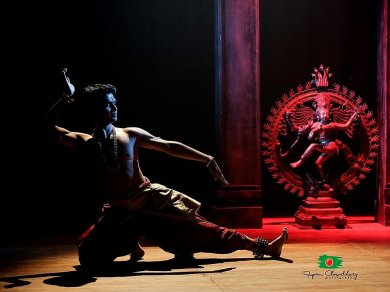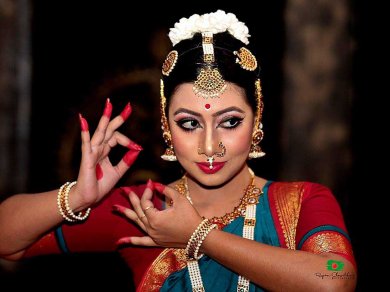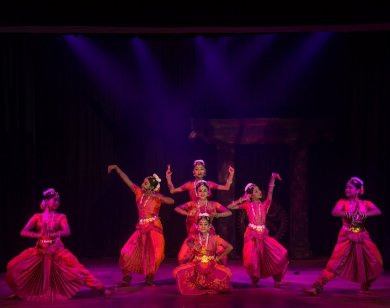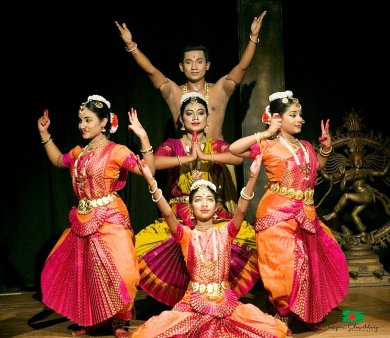
|   |

|   |
 e-mail: sunilkothari1933@gmail.com Two day Festival of Bharatanatyam at Dhaka University Pics courtesy: Shadhona Institute / Rupam Chowdhury July 10, 2018 In continuation of the two day festival of Manipuri dances celebrating birth centenary of Guru Bipin Singh, Lubna Marium arranged Rangasree Bharatanatyam Festival (June 24 & 25, 2018) showcasing artists of Shadhona at Nat Mandal Theatre Studies Department of Dhaka University. Two years ago, I had seen Amit Chowdhury and others at Khajuraho Dance Festival. Bangalore based Kirti Ramgopal, disciple of late Padmini Ramachandran, had trained him with few Bharatanatyam numbers including a varnam. In Bangladesh, Bharatanatyam performances by leading dancers from India are arranged by ICCR and Indian High Commission. Leela Samson, C.V. Chandrasekhar, Alarmel Valli have performed at Dhaka often. They have been also invited privately. Under ICCR, C.V. Chandrasekhar has often conducted Bharatanatyam workshops and offered training in Bharatanatyam. Other dance forms like Odissi and Mohiniattam have also been staged in Dhaka by Madhavi Mudgal and Bharati Shivaji. Lubna Marium has received training in Bharatanatyam at Kalakshetra for a brief period. She is anxious that Bharatanatyam dance form takes roots in Bangaldesh. Samson has trained a young Muslim dancer Anisul Islam Hero and he trains young students in Bharatanatyam. At Shadhona under Kolpotoru, several Rongoprobesh (arangetram) have been arranged in the past and regular training twice a week in Bharatanatyam is given. Amit Chowdhury supervises the classes. He is working in Theatre Studies Department and carries on practicing as well as learning whenever he gets opportunity. From Kolkata, Rajdeep Banerjee, a Bharatanatyam teacher, has earlier trained him in Bharatanatyam. Later on he took further lessons from Kirti Ramgopal. On the first day, Amit Chowdhury opened the performance with alarippu in seven beats. The Narasimha kavutvam was rendered with recitation and then the shloka was sung. The story of Hiranyakashipu and Prahalad was explained. Amit has a commendable stage presence. His movements are clean, diagonal arm movements also in order as also leg extension giving good impression of nritta. In varnam devoted to Vishnu, he showed sanchari of Gajendra Moksha and from Dashavatara, the incarnation of Vamana. Vamana, after scaling Bali with second leg asked where to place his third leg and Bali raja bows his head to Vishnu who places his foot on his head. The narrative was enacted with dramatic effect. In Devaranama of Purandaradasa when Lord Vishnu was in company of Lakshmi, Rishi Bhrigu visited them and was upset that he was not received properly and he kicked Lord Vishnu on his chest. Lord Vishnu took away the diamond from Bhrigu's foot, and Bhrigu realized his mistake of kicking the Lord on his chest. The episode was performed in a quick suggestive manner.  Amit Chowdhury  Arthy Ahmad Arthy Ahmad, a young Bharatanatyam dancer, presented "Krishna ni begane baro." The vataslya bhava, motherly love permeated her being and begging Krishna to come unto her was depicted in a convincing manner. Dressing him with Kashi pitambar and placing ankle bells on his feet telling him that he was more beautiful than even moon, were interesting nuances. Offering butter to Krishna, playing blindman's bluff, placing him in cradle, Krishna's running away, and eating mud, rebuking him and when Krishna opened his mouth and showed universe, Yashoda was overwhelmed and embraced her son. She showed in the end, Krishna sleeping in cradle. It was indeed praiseworthy that Arthy Ahmed projected these emotions competently. Amit performed Kirtanam incorporating Krishna's incarnation. The shloka "Kasturi tilakam lalata patale" preceded the main story of Bhasmasura and Mohini. After obtaining the boon of on whomever he would place his palm, would turn into ashes, the demon tried to test it by placing his palm on Lord Shiva, who ran to Lord Vishnu, who taking form of Mohini enticed the demon who expressed his desire to marry her. Mohini put up a condition that he should imitate whatever she was doing while dancing. Bhasmasura was lured into doing so and Mohini put her own palm on her head which Bhasmasura did and was turned into ashes. Amit succeeded in enacting the different characters. The Shiva Tandava lord performs at Pradosha hour before his consort Gauri seated on golden throne was vigorous in nature and also had joyous abandon. The utplavanas were executed artistically, the epithets of Nandivahana, Ganga flowing from lord's matted locks, playing damaru et al found felicitous projection. He rounded off his performance with tillana choreographed by Kriti Ramgopal. Amit has potential of being a brilliant male dancer. He needs to have more animation on his face for expressing bhavas. That would come with more practice and watching other artists whenever he gets opportunities. Lubna Marium feels that the theatre department should let him have more time to devote to dance. However, he is on the right path with whatever he has studied and is almost like a role model for other male dancers. On the second day, students of Kolpotoru Bharatanatyam wing performed Pushpanjali in group format. The Ganapati stuti of Muthuswami Dikshitar saw formation of icon of Ganapati by dancers creating interesting visuals. The young dancers included a girl who was ten years old and had started studying from the age of five. They seemed quite interested and involved. The senior students with five girls and one boy presented Pushpanjali and also prayer in praise of Ganapati depicting Pranavakara. Their training seemed sound in nritta. The Sabdam choreographed by Kirti Ragopal was in praise of Muruga and it included the story of his marriage with tribal princess Valli. Lord Muruga resides in Kandapuri. Set to Ragamalika and mishra chapu tala to composition by Thurayur Rajagopala Sharma, the presentation was flawless. The number in praise of three goddesses, Trimata samarpanam - Saraswati, Lakshmi and Parvati - in group format gave them scope for depicting them in their iconic forms. Goddess Saraswati holding a book in her hand, playing veena, holding a garland in right hand and so on, Lakshmi in her splendor form, Parvati, consort of Lord Shiva, to these three mothers the devotee bows. The devotional mood informed the presentation. 

Devaranama "Chandrachooda Siva Shankara" about all adornments of the lord had interesting choreographic episode when he is described as Nilakantha. The dancers depicted churning of the ocean. In the center Mandara mountain was shown around which the rope in form of serpent was held by devas on one side and the asuras on the other. From churning the ocean emerged poison which Lord Shiva decided to swallow, but Parvati touched the lord at his neck which turned dark, so the lord is addressed as Nilakantha. Tillana choreographed by Khagen Barman, a former Kalakshetra alumni and former professor at Rabindra Bharati University, in Vasanta raga and adi tala was in druta laya and the movement of periya adavu by the dancers in group of three was quite eye catching. It ended with the shloka from the Natyashastra which says there is no knowledge, no art which is not found in Natyashastra. The enthusiasm of the students was praiseworthy. Leela Venkataraman was requested to speak to the students. She rightly observed that in order to imbibe the spirit of Bharatanatyam, they must learn the language of dance, practice adavus, and also learn music, know the text of the songs. That will help them a lot. Lubna Marium wanted us to assess the standard and offer guidance. We both feel that Bharatanatyam in order to take roots in Bangladesh will need to have musicians, an mridangam artist and also a vocalist well versed in Carnatic music, because these are the two most important pillars of Bharatanatyam dance. And also the knowledge of languages like Tamil and Telugu for understanding the nuances for abhinaya. These are the prerequisites. Lubna has passion for dance and we feel that with these arrangements if the training is given, it will help Bharatanatyam take roots in Bangladesh. As a pioneer and visionary, Lubna Marium will surely see to it for having Bharatanatyam on a sound basis in Bangladesh.  Dr. Sunil Kothari is a dance historian, scholar, author and critic, Padma Shri awardee and fellow, Sangeet Natak Akademi. Dance Critics' Association, New York, has honoured him with Lifetime Achievement award. Post your comments Please provide your name and email id when you use the Anonymous profile in the blog to post a comment. All appropriate comments posted with name & email id in the blog will also be featured in the site. |